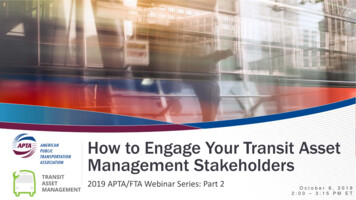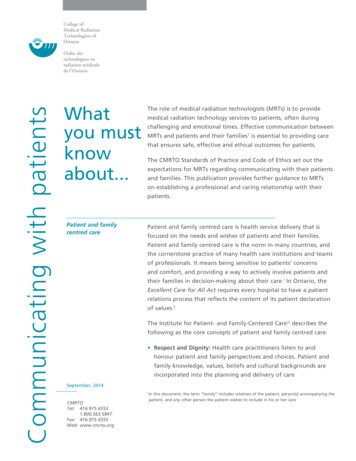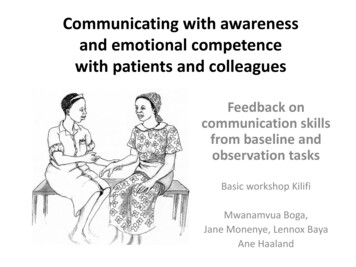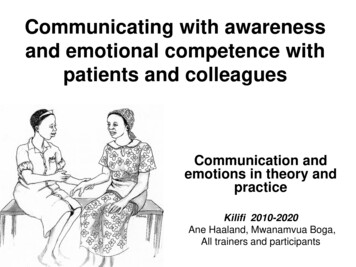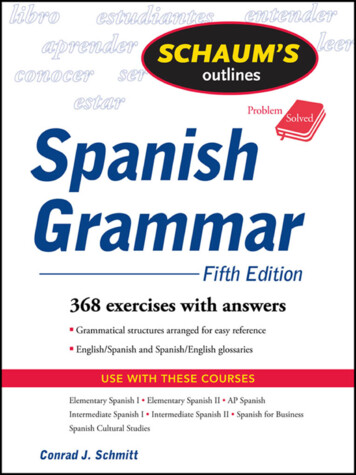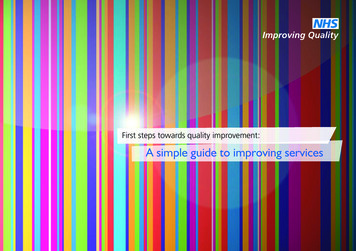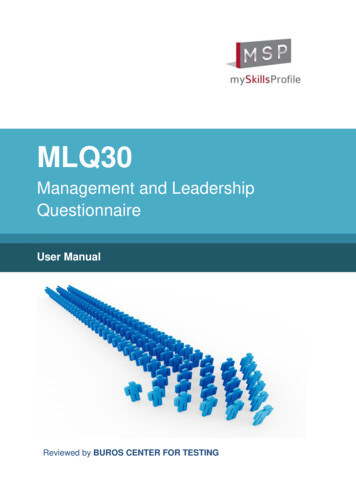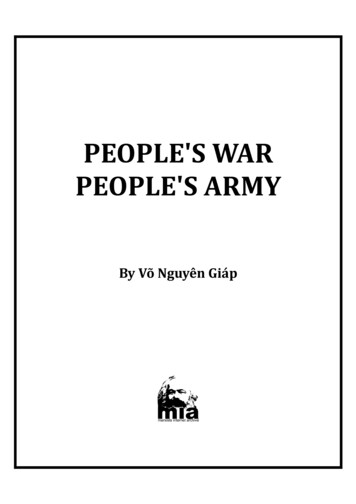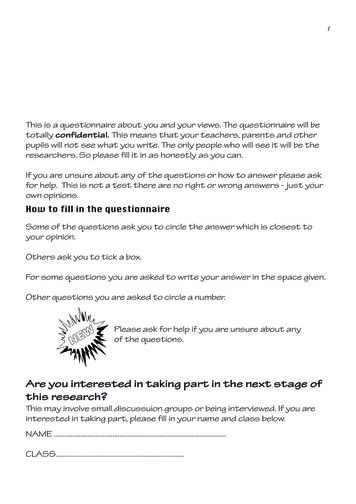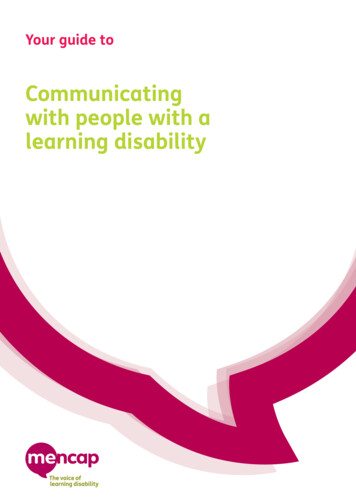
Transcription
Your guide toCommunicatingwith people with alearning disability
About this guideThis guide is designed to provide a brief introduction tocommunication, and the problems faced by someone with alearning disability. It also contains tips on how you can be a bettercommunicator, and how you can help someone with a learningdisability to get their message across.
ContentsCommunicating with people with a learningdisability4What is communication?5Having a communication difficulty6Being a good communication partner7Making communication work8Top tips for communication9Further help11Contacts12
4 Communicating with people with a learning disabilityCommunicating withpeople with a learningdisabilityWorking with someone with alearning disability may challengeyour idea of what communicationis, and how you make yourselfunderstood.It may make you think about your tone of voice and your bodylanguage as well as the words you use, and remind you thatcommunication is not just about talking but also about listening.“Communication is really important becausethat’s the way of expressing yourself. If wedon’t communicate clearly with each other,there’s no point in communicating at all.”
5What is communication?“The best way for somebody to communicatewith me is face-to-face, because you neverknow how the other person is feeling.”Everyone can communicate and everyone is an individual in the waythey communicate.There are hundreds of definitions of what communication is and howit is done.Perhaps the simplest way of thinking about communication is that itis the passing on of information from one person to another using anymeans possible.You may be surprised to know that we get most of our informationacross through our body language. The way people communicate ismade up of: Body language 55% Tone of voice 38% Words 7%
6 Communicating with people with a learning disabilityHaving a communicationdifficulty“Sometimes I’ve got the words in my mind, andI’m trying to explain it in the best possible way,but it doesn’t always come out.”Try to imagine not being able to read this not being able to tell someone else about it not being able to find the words you wanted to say opening your mouth and no sound coming out words coming out jumbled up not getting the sounds right words getting stuck, someone jumping in, sayingwords for you people assuming what you want, without checkingwith you not hearing the questions not being able to see, or not being able to understand,the signs and symbols around you not understanding the words, phrases or expressions not being able to write down your ideas being unable to join a conversation
7 people ignoring what you are trying to say, feelingembarrassed and moving away people not waiting long enough for you to respond insome way, assuming you have nothing to say andmoving away.(Adapted from material on the Communication Forum website atwww.communicationsforum.org.uk)“It makes me feel as if I’m not worthy of beingable to communicate. I can communicate, but ina different way to other people, and it makes mefeel quite upset when people don’t understand.”
8 Communicating with people with a learning disabilityBeing a good communicationpartner To be a successful communicator with people with alearning disability you need to be prepared to use allyour communication tools. You need to follow the lead of the person you arecommunicating with. You need to go at their pace.
9Making communication work“As long as they have the right support to learn,people with a learning disability can achieveanything. As long as you communicate thatsupport to somebody in an understanding way.”Whatever way you are trying to communicate with someone with alearning disability, there are some simple rules you can follow forgood communication. It is important to always use accessiblelanguage, and to avoid jargon or long words that might be hard tounderstand. You should also take into account any physicaldisabilities the person may have that could make communicationdifficult for them. In person: many people with a learning disability havetold Mencap that the best way to communicate withthem is face-to-face and one-to-one. In writing: it is a good idea to use bigger text andbullet points, and to keep writing at a minimum of 16point. It is also important to remember that too muchcolour can make reading harder for some people. On the phone: the best way to talk to someone with alearning disability on the phone is slowly and clearly,using easily understandable words.“When I had to go to the hospital the doctorswould usually speak to my mum rather thanspeak to me. So I didn’t bring her to the hospitalanymore. Finally they started to recognise I’mthe one, I need to understand, not my mum.”
10 Communicating with people with a learning disabilityTop tips for communication1. Find a good place to communicate inSomewhere quiet without distractions. If you are talking to a largegroup be aware that some people may find this difficult.2. Ask open questionsQuestions that don’t have a simple yes or no answer.3. Check with the person that you understand what theyare saying“The TV isn’t working? Is that right?”4. If the person wants to take you to show you something,go with them.“I showed my manager my idea on a piece ofpaper, then I spoke to him about it. It showedreally well what I meant, and that I’d made theeffort to communicate.”5. Watch the personThey may tell you things by their body language and facialexpressions.6. Learn from experienceYou will need to be more observant and don’t feel awkward aboutasking parents or carers for their help.7. Try drawingEven if your drawing is not great it might still be helpful.
118. Take your time, don’t rush your communication.“I’m quite good on the phone as long as peopletell me what they want and speak clearly andslowly. Then I can understand.”9. Use gestures and facial expressions.If you are asking if someone is unhappy make your facial expressionunhappy to reinforce what you are saying.10. Be aware that some people find it easier to use realobjects to communicate but photos and pictures canreally help too.Remember, all communication is meaningful, but you may need towork harder to understand.
12 Communicating with people with a learning disabilityFurther helpThe following websites and organisations contain information ondeveloping your communication skills and knowledge. Many people with a learning disability can use orrecognise some signs. Signalong and Makaton are bothSign Supported English systems. They are based onBritish Sign Language (BSL) but are used to support thespoken word. To find out more you can visit theSignalong website at www.signalong.org.uk or visit theMakaton website at www.makaton.org.uk To find out more about BSL, you can visit the British DeafAssociation at www.bda.org.uk Talking Mats are a communication system that usessymbols and other images. For more information, pleasevisit the Talking Mats website at www.talkingmats.com Widgit produce software and symbols to help withcommunication and accessibility. For more information,please visit the Widgit website at www.widgit.com Symbol World is a website run by Widgit for symbolusers that includes nursery rhymes, stories and amonthly magazine. For more information, please visitthe Symbol World website at www.symbolworld.org Clear Consultants is an organisation providing trainingand information on communication and accessibility.For more information please visit the ClearConsultants website at www.clearforall.co.ukFurther information and resources Royal College of Speech and Language TherapistsWebsite: www.rcslt.org.uk Communication MattersWebsite: www.communicationmatters.org.uk
14 Communicating with people with a learning disabilityContactsEnglandIf you live in England and would like more information on learningdisability, you can contact:The Learning Disability HelplineTelephone: 0808 800 1111Typetalk: 18001 0808 808 1111Email: help@mencap.org.ukIf English is not your first language and you would like access to atranslation service, please contact the Mencap helpline and ask forLanguage Line.Northern IrelandIf you live in Northern Ireland and would like more information onlearning disability, please contact:Mencap’s Information ServiceTelephone: 0808 800 1111Email: mencapni@mencap.org.ukWalesIf you live in Wales and would like more information on learningdisability, please contact:Wales Learning Disability HelplineTelephone: 0808 800 1111Email: information.wales@mencap.org.ukScotlandIf you live in Scotland, and would like more information on learningdisability, please contact:ENABLE ScotlandTelephone: 0141 226 4541Email: info@enable.org.ukWebsite: www.enable.org.uk
123 Golden LaneLondon EC1Y 0RTT: 020 7454 0454F: 020 7608 3254www.mencap.org.ukhelp@mencap.org.ukLearning DisabilityHelpine 0808 808 1111Registered Charity Number 2223772008.292 11.09
Symbol World is a website run by Widgit for symbol users that includes nursery rhymes, stories and a monthly magazine. For more information, please visit the Symbol World website at www.symbolworld.org Clear Consultants is an organisation providing tra
